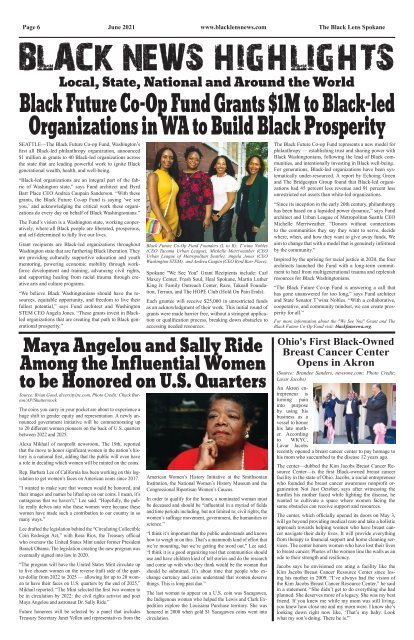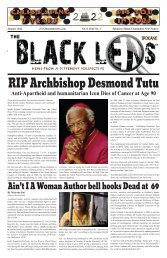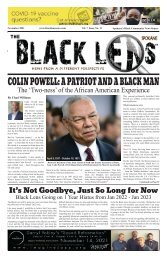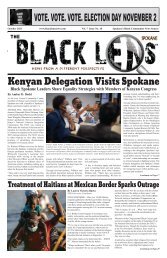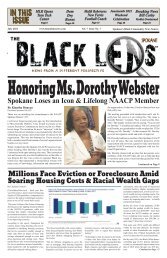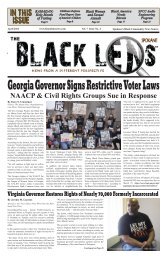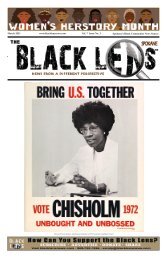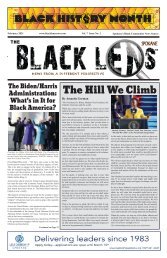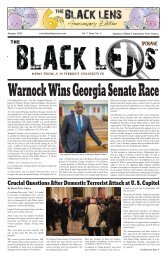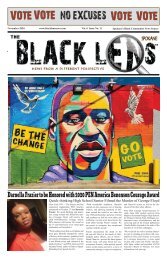Black Lens June 2021
The Black Lens is an independent, monthly, community newspaper based in Spokane, WA, that is focused on the news, information, people and events that are of importance of the Black community.
The Black Lens is an independent, monthly, community newspaper based in Spokane, WA, that is focused on the news, information, people and events that are of importance of the Black community.
You also want an ePaper? Increase the reach of your titles
YUMPU automatically turns print PDFs into web optimized ePapers that Google loves.
Page 6<br />
<strong>June</strong> <strong>2021</strong><br />
www.blacklensnews.com<br />
The <strong>Black</strong> <strong>Lens</strong> Spokane<br />
BLACK NEWS HIGHLIGHTS<br />
Local, State, National and Around the World<br />
<strong>Black</strong> Future Co-Op Fund Grants $1M to <strong>Black</strong>-led<br />
Organizations in WA to Build <strong>Black</strong> Prosperity<br />
SEATTLE—The <strong>Black</strong> Future Co-op Fund, Washington’s<br />
first all <strong>Black</strong>-led philanthropy organization, announced<br />
$1 million in grants to 40 <strong>Black</strong>-led organizations across<br />
the state that are leading powerful work to ignite <strong>Black</strong><br />
generational wealth, health, and well-being.<br />
“<strong>Black</strong>-led organizations are an integral part of the fabric<br />
of Washington state,” says Fund architect and Byrd<br />
Barr Place CEO Andrea Caupain Sanderson. “With these<br />
grants, the <strong>Black</strong> Future Co-op Fund is saying ‘we see<br />
you,’ and acknowledging the critical work these organizations<br />
do every day on behalf of <strong>Black</strong> Washingtonians.”<br />
The Fund’s vision is a Washington state, working cooperatively,<br />
where all <strong>Black</strong> people are liberated, prosperous,<br />
and self-determined to fully live our lives.<br />
Grant recipients are <strong>Black</strong>-led organizations throughout<br />
Washington state that are furthering <strong>Black</strong> liberation. They<br />
are providing culturally supportive education and youth<br />
mentoring, powering economic mobility through workforce<br />
development and training, advancing civil rights,<br />
and supporting healing from racial trauma through creative<br />
arts and culture programs.<br />
“We believe <strong>Black</strong> Washingtonians should have the resources,<br />
equitable opportunity, and freedom to live their<br />
fullest potential,” says Fund architect and Washington<br />
STEM CEO Angela Jones. “These grants invest in <strong>Black</strong>led<br />
organizations that are creating that path to <strong>Black</strong> generational<br />
prosperity.”<br />
Maya Angelou and Sally Ride<br />
Among the Influential Women<br />
to be Honored on U.S. Quarters<br />
Source: Brian Good, diversityinc.com, Photo Credit: Chuck Burton/AP/Shutterstock<br />
The coins you carry in your pocket are about to experience a<br />
huge shift in gender equity and representation. A newly announced<br />
government initiative will be commemorating up<br />
to 20 different women pioneers on the back of U.S. quarters<br />
between 2022 and 2025.<br />
Alexa Mikhail of nonprofit newsroom, The 19th, reported<br />
that the move to honor significant women in the nation’s history<br />
is a national first, adding that the public will even have<br />
a role in deciding which women will be minted on the coins.<br />
Rep. Barbara Lee of California has been working on this legislation<br />
to get women’s faces on American coins since 2017.<br />
“I wanted to make sure that women would be honored, and<br />
their images and names be lifted up on our coins. I mean, it’s<br />
outrageous that we haven’t,” Lee said. “Hopefully, the public<br />
really delves into who these women were because these<br />
women have made such a contribution to our country in so<br />
many ways.”<br />
Lee drafted the legislation behind the “Circulating Collectible<br />
Coin Redesign Act,” with Rosa Rios, the Treasury official<br />
who oversaw the United States Mint under former President<br />
Barack Obama. The legislation creating the new program was<br />
eventually signed into law in 2020.<br />
“The program will have the United States Mint circulate up<br />
to five chosen women on the reverse (tail) side of the quarter-dollar<br />
from 2022 to 2025 — allowing for up to 20 women<br />
to have their faces on U.S. quarters by the end of 2025,”<br />
Mikhail reported. “The Mint selected the first two women to<br />
be in circulation by 2022: the civil rights activist and poet<br />
Maya Angelou and astronaut Dr. Sally Ride.”<br />
Future honorees will be selected by a panel that includes<br />
Treasury Secretary Janet Yellen and representatives from the<br />
<strong>Black</strong> Future Co-Op Fund Founders (L to R): T’wina Nobles<br />
(CEO Tacoma Urban League), Michelle Merriweather (CEO<br />
Urban League of Metropolitan Seattle), Angela Jones (CEO<br />
Washington STEM), and Andrea Caupin (CEO Byrd Barr Place).<br />
Spokane "We See You" Grant Recipients include: Carl<br />
Maxey Center, Fresh Soul, Heal Spokane, Martin Luther<br />
King Jr. Family Outreach Center, Raze, Takeall Foundation,<br />
Terrain, and The HOPE Club (Hold On Pain Ends).<br />
Each grantee will receive $25,000 in unrestricted funds<br />
as an acknowledgment of their work. This initial round of<br />
grants were made barrier free, without a stringent application<br />
or qualification process, breaking down obstacles to<br />
accessing needed resources.<br />
American Women’s History Initiative at the Smithsonian<br />
Institution, the National Women’s History Museum and the<br />
Congressional Bipartisan Women’s Caucus.<br />
In order to qualify for the honor, a nominated woman must<br />
be deceased and should be “influential in a myriad of fields<br />
and time periods including, but not limited to, civil rights, the<br />
women’s suffrage movement, government, the humanities or<br />
science.”<br />
“I think it’s important that the public understands and knows<br />
how to weigh in on this. That’s a mammoth kind of effort that<br />
we’re mounting, but we’re getting the word out,” Lee said.<br />
“I think it is a good organizing tool that communities should<br />
use and have children kind of tell stories and do the research<br />
and come up with who they think would be the woman that<br />
should be submitted. It’s about time that people who exchange<br />
currency and coins understand that women deserve<br />
things. This is long past due.”<br />
The last woman to appear on a U.S. coin was Sacagawea,<br />
the Indigenous woman who helped the Lewis and Clark Expedition<br />
explore the Louisiana Purchase territory. She was<br />
honored in 2000 when gold $1 Sacagawea coins went into<br />
circulation.<br />
The <strong>Black</strong> Future Co-op Fund represents a new model for<br />
philanthropy — establishing trust and sharing power with<br />
<strong>Black</strong> Washingtonians, following the lead of <strong>Black</strong> communities,<br />
and intentionally investing in <strong>Black</strong> well-being.<br />
For generations, <strong>Black</strong>-led organizations have been systematically<br />
under-resourced. A report by Echoing Green<br />
and The Bridgespan Group found that <strong>Black</strong>-led organizations<br />
had 45 percent less revenue and 91 percent less<br />
unrestricted net assets than white-led organizations.<br />
“Since its inception in the early 20th century, philanthropy<br />
has been based on a lopsided power dynamic,” says Fund<br />
architect and Urban League of Metropolitan Seattle CEO<br />
Michelle Merriweather. “Donors without connections<br />
to the communities they say they want to serve, decide<br />
where, when, and how they want to give away funds. We<br />
aim to change that with a model that is genuinely informed<br />
by the community.”<br />
Inspired by the uprising for racial justice in 2020, the four<br />
architects launched the Fund with a long-term commitment<br />
to heal from multigenerational trauma and replenish<br />
resources for <strong>Black</strong> Washingtonians.<br />
“The <strong>Black</strong> Future Co-op Fund is answering a call that<br />
has gone unanswered for too long,” says Fund architect<br />
and State Senator T’wina Nobles. “With a collaborative,<br />
cooperative, and community mindset, we can create prosperity<br />
for all.”<br />
For more information about the "We See You" Grant and The<br />
<strong>Black</strong> Future Co-Op Fund visit: blackfuturewa.org.<br />
Ohio's First <strong>Black</strong>-Owned<br />
Breast Cancer Center<br />
Opens in Akron<br />
(Source: Brandee Sanders, newsone.com; Photo Credit:<br />
Lavar Jacobs)<br />
An Akron entrepreneur<br />
is<br />
turning pain<br />
into purpose<br />
by using his<br />
business as a<br />
vessel to honor<br />
his late mother.<br />
According<br />
to WKYC,<br />
Lavar Jacobs<br />
recently opened a breast cancer center to pay homage to<br />
his mom who succumbed to the disease 12 years ago.<br />
The center—dubbed the Kim Jacobs Breast Cancer Resource<br />
Center—is the first <strong>Black</strong>-owned breast cancer<br />
facility in the state of Ohio. Jacobs, a social entrepreneur<br />
who founded the breast cancer awareness nonprofit organization<br />
Not Just October, says after witnessing the<br />
hurdles his mother faced while fighting the disease, he<br />
wanted to cultivate a space where women facing the<br />
same obstacles can receive support and resources.<br />
The center, which officially opened its doors on May 3,<br />
will go beyond providing medical care and take a holistic<br />
approach towards helping women who have breast cancer<br />
navigate their daily lives. It will provide everything<br />
from therapy to financial support and home cleaning services.<br />
The center honors women who have lost their lives<br />
to breast cancer. Photos of the women line the walls as an<br />
ode to their strength and resiliency.<br />
Jacobs says he envisioned cre ating a facility like the<br />
Kim Jacobs Breast Cancer Resource Center since losing<br />
his mother in 2009. “I’ve always had the vision of<br />
the Kim Jacobs Breast Cancer Resource Center,” he said<br />
in a statement. “She didn’t get to do everything she had<br />
planned. She deserves more of a legacy. She was my best<br />
friend. If you knew me while my mom was still living,<br />
you knew how close me and my mom were. I know she’s<br />
looking down right now like, ‘That’s my baby. Look<br />
what my son’s doing. There he is.'”


